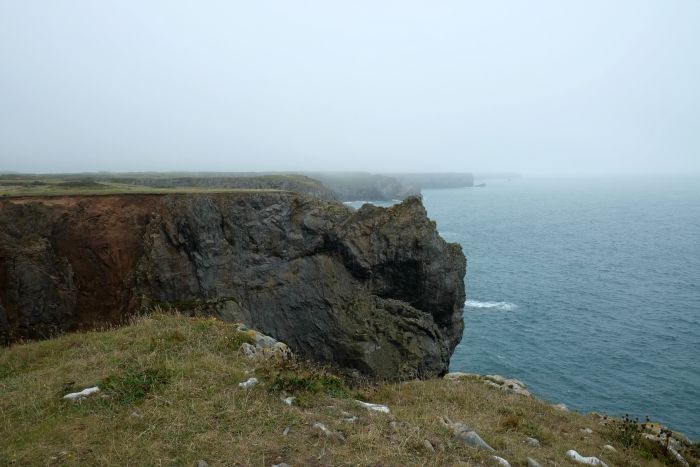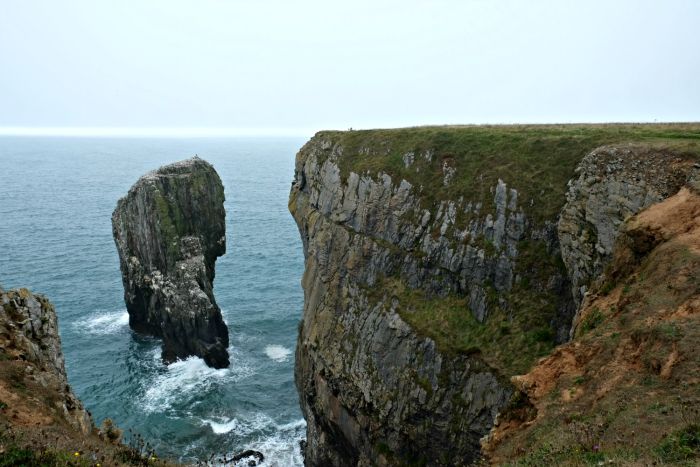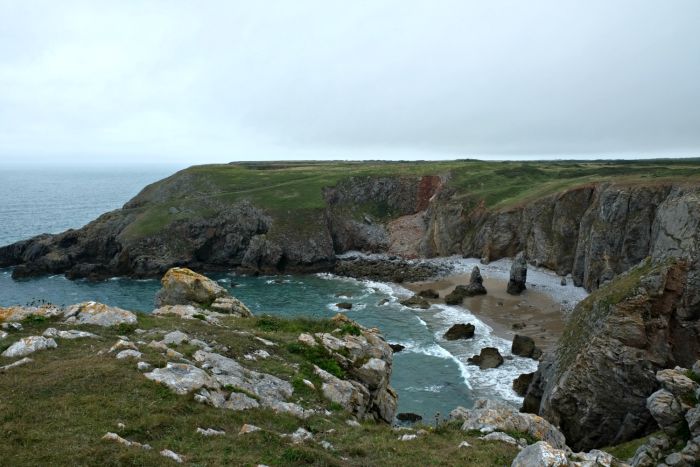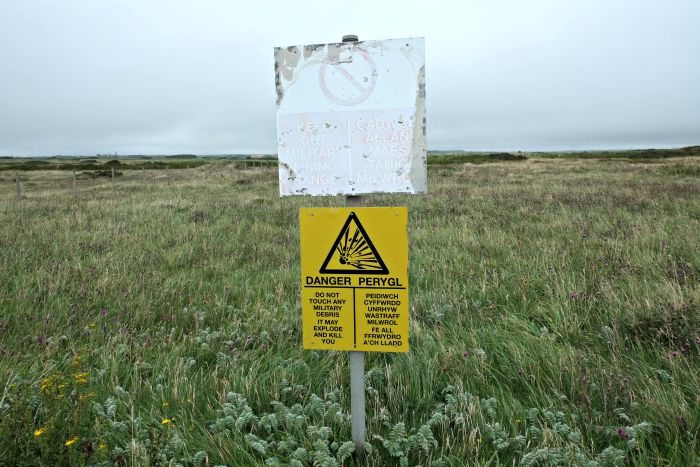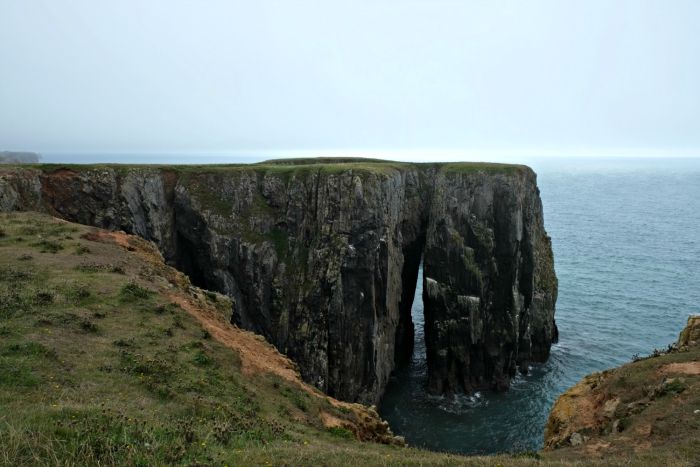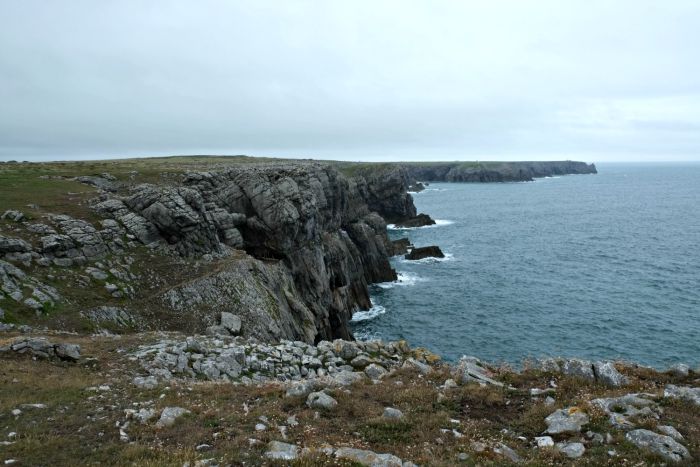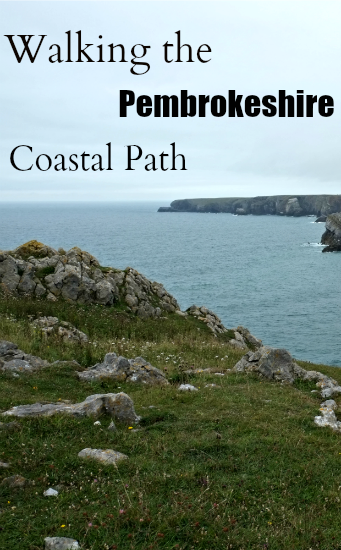I’m sitting on the side of the bed in a guest house in Tenby with a blanket over my shoulders. It’s 11.30 p.m. and I’m nervous. Tomorrow I’ll walk a part of the Pembrokeshire Coastal Path here in Wales, the UK.
It’s only a small part, no biggie.
That’s what I thought until I realized, about an hour ago, that the Coastal Path runs along cliffs. How could I have missed that all the photos I’ve seen during my research were taken from above, looking down on the beaches?
I Googled: “Coastal Path Wales fear of heights”. Just a few relevant results, but none related to the part that I’d be walking. I’ll be fine, right?
A year ago, I was so proud of myself for going skiing for the first time. For taking a ski lift for the first time. For setting that irrational fear aside. I thought I’d be able to deal with it from then on. Fact is that I haven’t. Not really. Each time my travels take me to a Castle wall, a mountain, a pedestrian bridge or a massive rock I try to walk it, climb it, cross it. Sometimes I almost run, praying that those in front of me won’t suddenly halt. Sometimes I’ll freeze in the middle, feeling nauseous and trembling. Sometimes I’ll wait until everyone is out of sight so that nobody will see me in case I want to walk back. Stop. No further.
It annoys me. Heights mean views mean good photographs. I need photographs. Not for me, but for you. I want to show you all there is to see so that you’ll know why a place is worth visiting. But I can’t. Not always. And for that I’m sorry.
Tomorrow I’ll start my walk armed with camera, smartphone, GoPro and Nikes, determined to finish that little stretch I’ve chosen to walk.
Fast forward. I’m back home, writing this post.
From Stack Rocks car park to St. Govan’s Chapel on the Pembrokeshire Coastal Path
The sky was dark when I got out of the car at Stack Rocks car park. It was clouded but still dry. I set out on my walk to St. Govan’s Chapel, about 3 miles (4.8 km) ahead, with my camera around my neck and my GoPro ready to film.
I was going to walk part of the Pembrokeshire Coastal Path, a 186 miles (299 km) long walking route along the coast of Wales.
I’d found a handy description of my part of the walking route online, but the route between Stack Rocks car park and St. Govan’s Chapel is so clearly marked that you really can’t get lost.
The Pembrokeshire Coastal Path starts in the north of Wales at St. Dogmaels and ends in the south at Amroth. Opened to the public in 1970, it was the first National Trail in Wales.
Hikers on the Pembrokeshire Coastal Path pass through all kinds of landscapes, from green flats along rugged cliffs and past hidden coves. But nature isn’t the only attraction on the trail. Man has left his trace here throughout the ages, with remnants of the Neolithic and the Iron Age still visible today.
Before I started walking, I headed over to the cliffs to check the Stack Rocks. I was immediately happy that I could look down at the ocean from above without suffering from my fear of heights. Unlike other parts of the Wales Coastal Path, the walk between Stack Rocks car park and St. Govan’s Chapel runs through flat land and you don’t need to go near the cliffs unless you want to. It’s not like that on other parts of the path!.
Stack Rocks are two large limestone rock pillars sticking out of the ocean. They used to be part of the mainland, but the sea eroded the rock, leaving only these pillars or stacks.
There are several along the Pembrokeshire Coastal Path, but Stack Rocks actually have a car park named after them, making them very easy to find. When you park at Stack Rocks car park, there’s an information sign pointing right to them.
Stack Rocks are also a great place to go bird spotting in spring and early summer. It’s then that the guillemots, kittiwakes and other seabirds make their nests there. By the way: the Welsh word for guillemot is “elelug”, which explains why the Stack Rocks are called the Elelug Stacks by the locals.
To the left of the Stack Rocks car park is a gate. It’s where my walk towards St. Govan’s Chapel started. As said, the path runs a safe distance from the cliffs, but I regularly walked out into the longer green grass to get a better view of the ocean and the cliffs. It’s okay, you can go off-path and by the few tracks in the grass I could see I wasn’t the only one doing so. You kind of have to if you want to get the best views.
Speaking of the views, I often found myself going “Wow”, without having anyone particular to say it too. Although I at times wished I was walking the path with someone else who I could share this experience with, I also couldn’t help but think that walking along the coast of Wales was like meditating if you did it by yourself. There’s really nothing there but nature and so you’re really alone with your thoughts.
Alone, but constantly reminded of other human presence as this part of the Pembrokeshire Coastal Path lies within the Castlemartin fire range. That means that you have to check beforehand whether the area is open during the time of your visit or not and when it’s open, you still have to keep to the right side of the wire. Every few miles there will be a sign reminding you not to drift off into the exercise field.
I’d almost reached my return point, St. Govan’s Chapel, when it started to rain.
Darn!
I knew I couldn’t be far and I wasn’t going to turn back before I’d reached my goal, now was I? No, I wasn’t.
But there was another hurdle.
In front of me stood a herd of cows. Big, muscular cows. As I approached I saw their heads turning towards me. They were standing on both sides of the path and I would have to walk right past them to continue my journey. I could see them staring at me and so I tried to look at the ground, only glimpsing up now and then to see that they still had their eyes fixed on me. After what seemed to take an eternity I’d passed the herd and was now only a few minutes away from St. Govan’s Chapel.
St. Govan’s Chapel is a single-room chapel or hermit cell built into the limestone rock at St. Govan’s Chapel. It dates back to the 6th century, but most of it was built in the 13th century. It was named after Saint Govan, an Irish monk who supposedly moved into a cave right by the spot where you can now find the chapel. However, it’s still unclear who Saint Govan exactly was. Some stories even claim that he cas Sir Gawain, one of King Arthur’s knights. I guess we might never know.
You can get to the chapel by descending a flight of 52 steps, although legend has it then when you count the steps, the number is never the same going back up as it is going down.
I was soaked when I reached St. Govan’s Chapel. Not just that, but the steps to the chapel were wet and slippery as well and I decided it wouldn’t be a good idea to walk down in this weather. It was raining so hard I didn’t even take my camera out as I didn’t want it to get damaged.
A bit disappointed about this anti-climax I turned back. The walk there had taken me 1.5 hours, but I knew I could make it back in an hour as I’d been taking a lot of photos and had been filming during the first part of the walk.
I passed a few other hikers on the way. We said hello, but always quickly kept on walking as every hiker was just as soaked as the next one. There are no places to hide on this part of the path, so you better make sure you’re wearing proper rain clothes and waterproof shoes!
After about an hour, I made it back to the car park, where I exchanged my wet socks and sneakers for dry ones. It was time for a cup of tea.
If you want to know what else I did in Wales, check out this video or read my post about Cardiff.
Practical information on walking the Pembrokeshire Coastal Path
Pembrokeshire Coastal Path from Stack Rocks to St. Govan’s Chapel: 6.3 miles or 10.1 km there and back.
There’s a free car park both at Stack Rocks and at St. Govan’s Chapel.
To get to Stack Rocks:
Enter Emigrate Lane, Castlemartin into your gps. Depending on where you come from, you’ll first drive through a very narrow bit of the lane or you’ll reach the lane at a crossroads. At that crossroads you’ll find the entry gate to the Castlemartin fire range. It will say whether the range is open to the public or not, but you’re best to look this up beforehand. Drive through the gate and don’t be surprised as you’ll still have to drive several minutes before you’ll get to the actual car park. At a certain point, right before you’re there, the road will bend to the left. Be sure to follow it as going straight will take you to a small church, but it’s not where you need to be.
To get to St. Govan’s car park:
Drive to Bosherston and follow a small local and what appears to be nameless road to St. Govan’s car park.
If you don’t feel like walking the distance twice to get back to your car, like I did, you can take the Coastal Cruiser. This bus is part of a larger network of Pembrokeshire Coastal Path buses that takes hikers from and to different starting points along the trail. Make sure to check the timetables before you leave, though, as these buses don’t run that frequently.
If it’s not pouring, or you’re more of a badass than I am, walk a bit beyond Saint Govan’s towards the Lily Ponds at Bosherston. They’re part of a National Nature Reserve.
This is a good description of the walk from Stack Rocks to St. Govan’s Chapel.
Don’t forget to check if this part of the walk is open or closed due to firing exercises.
Lastly, please, wear proper clothing. Of course, there’s no need for rain gear on a sunny day, but make sure you pack some when you leave for Wales. People in Wales don’t stay in when it rains. Why would they? There’s so much beautiful nature to see. But they do dress appropriately and so do you, so make sure you pack a decent raincoat and waterproof shoes.
I drove to Stack Rocks from Tenby, where I spent two nights at the Langdon Villa guesthouse. I had a small but lovely room there and the hosts were super friendly and helpful. The guesthouse was located a 5-minute walk from the center and right by the train station, which was convenient as I could park at the car park there. A lot of street parking in Tenby is for residents only.
Pin for later
YOU MIGHT ALSO LIKE:
Introducing St Davids: smallest city and beautiful peninsula in Wales
24 hours in Cardiff, Wales
I traveled to Wales on behalf of VisitBritain, who took care of my accommodation, transportation, food and activity costs. Please know that I’ll always give you my honest opinion on every trip I take.

